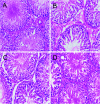Grape seed proanthocyanidin extract alleviates high-fat diet induced testicular toxicity in rats
- PMID: 35517006
- PMCID: PMC9063472
- DOI: 10.1039/c9ra01017c
Grape seed proanthocyanidin extract alleviates high-fat diet induced testicular toxicity in rats
Erratum in
-
Correction: Grape seed proanthocyanidin extract alleviates high-fat diet induced testicular toxicity in rats.RSC Adv. 2025 Feb 24;15(8):6076. doi: 10.1039/d5ra90018b. eCollection 2025 Feb 19. RSC Adv. 2025. PMID: 39995457 Free PMC article.
Abstract
The present study aimed to investigate the protective effects of grape seed proanthocyanidin extract (GSPE) on high-fat diet (HFD) induced testicular damage, oxidative stress, and apoptotic germ cell death. Male rats (n = 40) were randomly divided into four groups: the control group (treated with physiological saline), HFD group, HFD + GSPE (100 mg kg-1) group and HFD + GSPE (300 mg kg-1) group. Compared with the HFD group the rats of the GSPE-treated group showed improved serum testosterone levels, sperm quality and histological appearance of the testis tissue. Significant elevation of antioxidant enzyme (SOD, GSH, and GSH-Px) activities and remarkable reduction in MDA were also observed by GSPE administration, indicating that GSPE can decrease testicular oxidative stress. Finally, a significant reduction in spermatogenic cell apoptosis was detected by TUNEL assay. In summary, these results indicated that GSPE can suppress testicular dysfunction and this effect may be attributed to its antioxidant and anti-apoptotic properties. The current study indicates that GSPE can be considered a promising candidate for use as a drug or a food supplement to alleviate HFD-induced testicular dysfunction.
This journal is © The Royal Society of Chemistry.
Conflict of interest statement
The authors declare that there are no conflicts to declare.
Figures






Similar articles
-
Coenzyme Q10 alleviates testicular endocrine and spermatogenic dysfunction induced by high-fat diet in male Wistar rats: Role of adipokines, oxidative stress and MAPK/ERK/JNK pathway.Andrologia. 2022 Nov;54(10):e14544. doi: 10.1111/and.14544. Epub 2022 Jul 27. Andrologia. 2022. PMID: 35899326
-
Grape seed procyanidins extract attenuates Cisplatin-induced oxidative stress and testosterone synthase inhibition in rat testes.Syst Biol Reprod Med. 2018 Aug;64(4):246-259. doi: 10.1080/19396368.2018.1450460. Epub 2018 Apr 3. Syst Biol Reprod Med. 2018. PMID: 29613814
-
Grape seed proanthocyanidin extract ameliorates cisplatin-induced testicular apoptosis via PI3K/Akt/mTOR and endoplasmic reticulum stress pathways in rats.J Food Biochem. 2021 Jun 21:e13825. doi: 10.1111/jfbc.13825. Online ahead of print. J Food Biochem. 2021. PMID: 34152018
-
Grape Seed Proanthocyanidin Extract Alleviates Arsenic-induced Oxidative Reproductive Toxicity in Male Mice.Biomed Environ Sci. 2015 Apr;28(4):272-80. doi: 10.3967/bes2015.038. Biomed Environ Sci. 2015. PMID: 25966753 Free PMC article.
-
Molecular mechanisms of cardioprotection by a novel grape seed proanthocyanidin extract.Mutat Res. 2003 Feb-Mar;523-524:87-97. doi: 10.1016/s0027-5107(02)00324-x. Mutat Res. 2003. PMID: 12628506 Review.
Cited by
-
Green Coffea arabica Extract Ameliorates Testicular Injury in High-Fat Diet/Streptozotocin-Induced Diabetes in Rats.J Diabetes Res. 2020 Jun 12;2020:6762709. doi: 10.1155/2020/6762709. eCollection 2020. J Diabetes Res. 2020. PMID: 32626781 Free PMC article.
-
Antioxidant/Pro-Oxidant Actions of Polyphenols From Grapevine and Wine By-Products-Base for Complementary Therapy in Ischemic Heart Diseases.Front Cardiovasc Med. 2021 Nov 3;8:750508. doi: 10.3389/fcvm.2021.750508. eCollection 2021. Front Cardiovasc Med. 2021. PMID: 34805304 Free PMC article. Review.
-
Grape Winemaking By-Products: Current Valorization Strategies and Their Value as Source of Tannins with Applications in Food and Feed.Molecules. 2025 Jun 25;30(13):2726. doi: 10.3390/molecules30132726. Molecules. 2025. PMID: 40649244 Free PMC article. Review.
-
Grape Seeds Proanthocyanidins: An Overview of In Vivo Bioactivity in Animal Models.Nutrients. 2019 Oct 12;11(10):2435. doi: 10.3390/nu11102435. Nutrients. 2019. PMID: 31614852 Free PMC article. Review.
-
Ameliorating high-fat diet-induced sperm and testicular oxidative damage by micronutrient-based antioxidant intervention in rats.Eur J Nutr. 2022 Oct;61(7):3741-3753. doi: 10.1007/s00394-022-02917-9. Epub 2022 Jun 16. Eur J Nutr. 2022. PMID: 35708759 Free PMC article.
References
-
- Liu Y. Ding Z. Obesity, a serious etiologic factor for male subfertility in modern society. Reproduction. 2017;154:R123–R131. - PubMed
LinkOut - more resources
Full Text Sources

